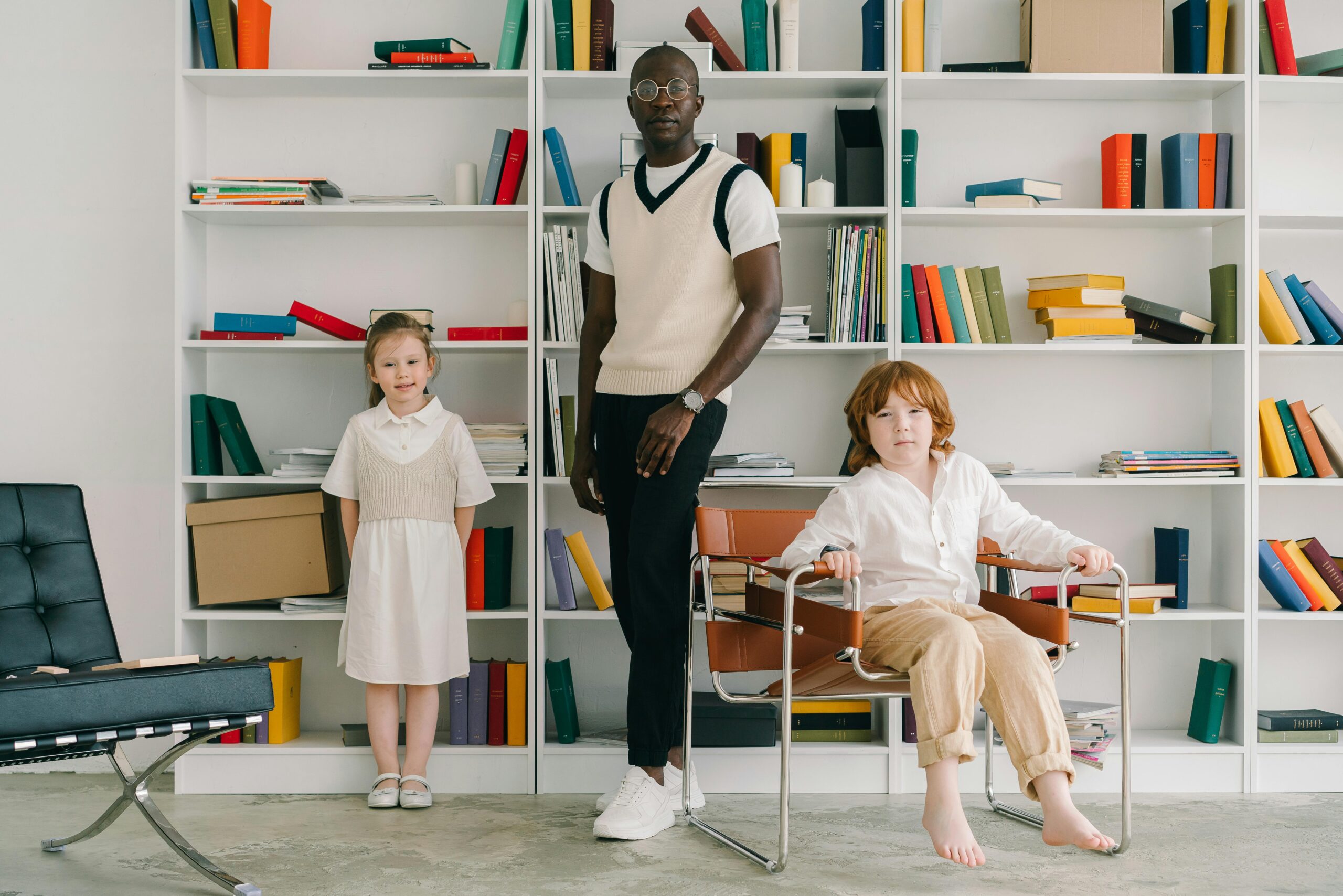Introduction
Whether you’re a teacher setting up a new classroom, a director planning a preschool centre, or a parent creating a productive learning zone at home, the environment matters. A well-designed space doesn’t just hold children—it invites them to explore, focus, create, collaborate, and rest. As education shifts beyond chalkboards to flexible, interactive, and inclusive formats, the tools and furnishings we use must keep up.
In this post, we’ll explore how to strategically design and stock learning environments: choosing foundational furnishings, integrating interactive materials, planning for workflow and movement, supporting multiple age-groups, and building a space that can grow and adapt. Whether you’re working with a large centre or a household learning nook, the same principles apply.
1. Understanding the Modern Learning Environment
From Rows and Chairs to Zones and Flow
Traditional classrooms often featured rigid rows, fixed desks, and one teacher at the front. Today’s learning environments—early childhood centres, home schooling areas, after-school spaces—are far more dynamic. They accommodate group work, individual quiet time, hands-on tasks, technology integration, and circulation.
When designing, ask:
- How do students move between zones?
- Where will instruction happen vs independent work?
- How will transitions be managed (from play to work, group to individual)?
Furnishing choices must support flexibility, rather than fixity.
Age-Appropriate Design Considerations
A preschool centre has very different needs compared to an elementary or home-learning space. For younger children: lower furniture, safe materials, lots of open floor space, sensory-rich zones. For older learners: ergonomic chairs, workstations, shelving for materials, display walls.
Plan with the full learner lifecycle in mind, especially if the space will serve children of various ages (infants/toddlers through school-age). This helps avoid recreating the space too frequently and makes better use of budget.

Inclusivity and Differentiation
Modern classrooms must cater to a wide spectrum of learners: diverse backgrounds, abilities, learning styles, and needs. That means:
- Flexible seating (for movement, choice)
- Clear visual supports and organization
- Zones for sensory breaks, quiet time
- Accessible furniture and materials
When selecting supplies and furniture, consider universal design principles so every child feels included and supported.
2. Foundational Furnishings: Invest Where It Counts
What Makes a “Foundation” Piece?
In your learning space, foundation pieces are the items you’ll use daily and change rarely. These include major furniture (tables, storage units, chairs), durable shelving, work-zone surfaces. Characteristics of good foundation pieces:
- Sturdy materials (solid wood, durable metal or laminate)
- Good ergonomics (height that matches age group, adjustable where needed)
- Quality finishes that withstand wear, spills, cleaning
- Neutral styling so the space can adapt over time
These are investments that pay off over years—less time replacing or repairing.
Budget Allocation Strategy
When planning your budget for outfitting a classroom or learning zone, divide your spending roughly as follows:
- Major furniture (40-50 % of budget): tables, storage, chair sets
- Interactive kits and materials (25-30 %): manipulatives, STEM kits, art supplies
- Decor, finishes, finishing touches (20-30 %): rugs, lighting, display boards, comfort seating
This ensures the backbone of the space is strong first, then the fun and engagement elements build on top.
Material & Safety Considerations
In an educational environment, materials and finishes must meet stricter demands: safety compliance, abrasion resistance, easy cleaning, non-toxic surfaces. For instance:
- Tables with rounded edges and safe finishes
- Chairs with stable bases and no tipping hazard
- Storage units anchored to walls to prevent tipping
- Fabrics that resist stains and are easy to sanitize
Selecting trusted suppliers who list safety and durability ratings is key.
Example: The Multi-Use Table
One of the most used pieces in any learning space is the table. How to choose it well:
- Size: Large enough for collaboration but sized appropriately for the room.
- Height: Adjustable or age-appropriate height if children range in age.
- Finish: Workable for crafts, STEM, and meals if needed; wipe-clean surface.
- Shape: Rectangular for group work, or round/oval for circle time and discussion.
By choosing a strong table early, you anchor the space for multiple uses.
3. Interactive Materials & Supplies: Fuel for Engagement
Stocking the Right Materials
Furnishings create the environment, but materials make it come alive. Consider categories:
- Manipulatives: Counting beads, blocks, patterns—supporting math and cognition.
- Art supplies: Colors, textures, media for open-ended creativity.
- STEM/STEAM kits: Coding, robotics, investigation kits to keep pace with modern learning.
- Literacy & early-learning tools: Phonics cards, reading racks, language-rich visuals.
- Sensory and wellbeing tools: Fidgets, soft seating, calming corners.
When you source materials, look for bulk or kit options (common in major suppliers) to optimize cost and consistency.
Mapping Materials to Learning Goals
Rather than buying “what looks fun”, connect materials with clear learning objectives:
- If your goal is fine-motor development, choose manipulatives with small sizes and textured surfaces.
- If collaboration is key, pick kits that allow group work, shared tasks.
- For multilingual learners, select visual supports and multi-sensory tools.
Incorporate a rotation plan: refresh materials periodically so interest remains high and learning stays dynamic.
Organization & Storage for Materials
Having quality materials means little if they’re not accessible and well-stored. Best practices:
- Use clear bins labelled clearly; group by theme or learning domain.
- Use shelving at child-height so learners can access and return materials independently.
- Use vertical space (walls, pegboards) for display and storage.
- Allocate a “materials check-out” system or rotation schedule so materials stay in good condition.
By planning storage alongside materials purchase, you improve usability and prolong lifespan.
Creating a Rich Learning Tool Kit
For educators or parents setting up a space: consider assembling a “tool kit” of essentials that travel across activities:
- Multi-surface markers and whiteboard (for brainstorming)
- Pulse timer or stopwatch (for timed tasks, self-monitoring)
- Clipboards and mobile seating for flexibility
- Mobile cart with “go-to” manipulatives (counters, shapes, grids)
- Blank canvases (paper, board) for emergent creativity
This kind of toolkit supports fluid transitions across modes of learning.
4. Designing Zones & Flow: Space That Works
Defining Functional Zones
A well-designed learning space has defined zones for distinct activities:
- Gathering/Instruction Zone: Where teacher or facilitator leads; vision board; seating for group instruction.
- Independent/Small-Group Zone: Tables or clusters for 2-4 learners working together or individually.
- Creative/Messy Zone: Art, STEM, play—materials present, surfaces suited to mess, easy to clean.
- Quiet/Reflection Zone: Soft seating, pillows, low lighting, minimal distractions—where learners can decompress or read.
- Storage/Transition Zone: Entry/exit, coat/storage, charts, timers—supports flow and order.
Mapping your space into these zones helps you allocate furniture and materials efficiently.
Pathways & Circulation
Movement matters. Consider how learners will navigate between zones, get materials, return to seat, and how adults will move through space. Best practice:
- Leave open pathways of at least 3 ft (or appropriate local standard) for ease and safety.
- Avoid major furniture blocking sight-lines or access to materials.
- Use rugs or floor markings to visually separate zones without erecting barriers.
Good circulation reduces disruptions, helps transitions, and supports independent movement.
Flexibility & Reconfigurability
Learning needs change over time—morning circle, activity, snack, cleanup. Your space must adapt:
- Use furniture on casters or lightweight that can be moved easily.
- Use modular units or tables that can be combined or separated.
- Use portable storage carts to pull materials into zones.
- Design for simplicity of reconfiguration: minimal tools, quick transitions.
By making the space flexible, you reduce downtime and maximize usable hours.
Considerations for Smaller or Home-Based Spaces
If you’re setting up a learning area in a home or compact room:
- Use multi-purpose furniture (desk/table that serves multiple functions).
- Vertical storage to save floor space.
- Clear sightlines from main adult work area (for supervision).
- Noise and distraction control: consider partitions, bookcases as partial barriers, rugs to absorb echo.
- Use wall-mounted fold-away tables or desks for occasional use.
With thoughtful planning, even small spaces can become rich learning zones.
5. Personalisation, Culture & Identity
Reflecting Learner Identity & Culture
A vibrant learning space reflects the identities and cultures of its learners. Consider:
- Displaying student-chosen art or work.
- Including books and materials that reflect diversity of backgrounds.
- Using collaborative murals or displays where learners contribute.
- Naming zones or shelves in inclusive and meaningful ways.
When learners see themselves represented, engagement and belonging increase.
Theme vs Timeless Style
While themed classrooms (jungle, under-sea, space) are common, a timeless design has advantages:
- Easier refresh (just update accents rather than full redesign)
- Less risk of early visual fatigue or dated decoration
- Budget-friendly: spend more on furniture/materials rather than décor.
If you choose a theme, pick one that aligns with your community or curriculum vision and use it via accent pieces rather than structural change.
Student Ownership & Agency
Give learners real responsibility and choice:
- Let them select how a zone is arranged (within safe limits)
- Use mobile materials carts they can manage
- Have students create the “classroom contract” and display it
- Rotate “environment managers” who help maintain zones
This builds agency, ownership and makes the space live rather than just being passive.
Comfort & Warmth
Beyond function, space must feel comfortable and welcoming:
- Use comfortable seating (bean bags, cushions) for reading corners
- Natural light, plants, warm colour accents support wellbeing
- Soft materials reduce noise, absorb sound
- Personal touches: student art, local crafts, seasonal displays
When learners feel safe and comfortable, they’re more open to exploration and active engagement.
6. Technology & Literacy Integration
Tech-Ready Furniture

Even early-learning zones now need to integrate technology: tablets, interactive boards, charging stations. Furniture considerations:
- Tables with cable management or modular power units
- Charging carts for devices
- Durable tablet stands or kiosks
- Open shelving for lightweight tech materials
Designing for tech avoids last-minute “where do we plug in?” issues.
Blending Physical & Digital Materials
Combine hands-on materials with tech-enabled tools:
- Use manipulatives alongside apps that visualize data or patterns
- Augment reading corners with e-readers or audio options
- Use digital cameras or tablets for children to document their work, then print/display results
- Keep printed and digital resources side by side so children practise both tactile and screen-based skills
By thoughtfully blending physical and digital spaces, you support a rich, balanced experience.
Supporting Digital Literacy & Safety
Design space with digital literacy in mind:
- Zones for quiet viewing or individual screen use
- Visual cues or signage about “device time” vs “hands-on time”
- Secure storage for devices and earphones
- Clean, manageable surfaces for collaborative tech tasks
Ensuring technology is incorporated smoothly supports deeper learning rather than distraction.
Easier Upgrades & Future-Proofing
Tech changes fast. Furniture and space planning should anticipate:
- Extra outlets or power strips in accessible but safe places
- Tables that can be retrofitted with tech rather than replaced
- Modular systems that allow addition of new devices or zones
- Storage for tech accessories (covers, cables, headphones)
By planning ahead, you reduce cost and disruption when updates happen.
7. Maintenance, Sustainability & Lifecycle Planning
Durable Materials and Easy Maintenance
With high-use environments (schools, centres, home learning areas), maintenance is key:
- Choose surfaces that resist chips, stains, moisture
- Upholstery that can be cleaned easily or have removable covers
- Storage and shelving that remain stable under frequent use
- Furniture with warranty, clear replacement policies
A little extra upfront investment often reduces downtime and replacement cost.
Sustainable Purchasing & Circular Use
Increasingly, educational supply providers emphasise sustainability—materials that last, can be repaired, or are recyclable. For your space:
- Buy quality rather than “cheap throw-away”
- Consider second-hand or refurbished shelving especially for storage
- Ask whether the supplier has take-back or recycling programs for furniture/materials
- Select materials with low-VOC finishes, responsibly sourced wood
Sustainability aligns with educational values and often savings over lifecycle.
Rotation & Renewal Strategy
Just like curriculum requires updates, your environment will evolve. Plan a schedule:
- Every 2–3 years review major furnishings: chairs worn? tables chipped?
- Annually review materials: what’s used/unused, what needs replacing
- Prepare for growth: new age groups, new formats (e.g., more tech, hybrid classes)
- Budget for renewal rather than full overhaul—smaller investments over time reduce big disruption
Having a lifecycle plan means your space stays current and functional.
Involving the Community for Stewardship
In educational spaces, maintenance and care are community efforts:
- Assign “environment caretakers” (older students help monitor furniture use)
- Hold orientation for new students about how to use/handle materials and furniture
- Display care instructions or simple check-lists (e.g., “Wipe table after use”, “Return materials to cabinet”)
When users feel ownership, the space lasts longer and functions better.
8. Budgeting & Shopping Strategy for Supplies
Smart Planning Before Purchase
Before you start ordering, follow these steps:
- Inventory what you already have (furniture, shelving, materials)
- Measure space (floor, wall length, windows, outlets)
- Prioritise zones based on highest need (instruction zone first, then materials zone, then decor)
- Build a “wishlist” with essential vs optional items
- Check supplier lead times (especially for furniture or custom finishes)
This planning helps you spread budget and avoid impulse buys.
Bulk Purchasing & Kit Options
Many education-supply providers offer kits (furniture + accessories) or bulk discounts for centres/schools. Advantages:
- Cost savings per unit
- Matching components (all chairs same height, all tables same finish) → better visual cohesion
- Reduced time in sourcing individually
If you have multiple rooms or centres, consider standardising across spaces to simplify future updates.
Phased Implementation
Rather than buying everything at once:
- Phase 1: foundation furniture (tables, chairs, shelving)
- Phase 2: materials and manipulatives
- Phase 3: decor, comfort seating, specialized zones
Phasing helps cash-flow, allows time to evaluate usage, and enables better decisions based on usage patterns.
Cost vs Value
When choosing products, look at cost per use rather than just upfront cost. Example: a table priced higher but lasting 10 years and used constantly is better value than a cheaper one replaced every 3 years.
Ask:
- Is the piece adjustable or flexible?
- Can it be upgraded rather than replaced?
- Is the material robust for high-traffic use?
Consider lifecycle cost, not just purchase price.
9. Real-world Examples & Case Studies
Early Childhood Centre Transformation
Imagine a new preschool centre: initially bare walls and minimal furniture. With a budget plan and a trusted supplier partner, the studio invests in:
- Adjustable-height infant/toddler tables with rounded edges, chairs in primary colours
- Open shelving with clear bins for materials (accessible to 2-4-year-olds)
- Cozy reading corner with floor cushions, small sofa, display board for student work
- Sensory zone with soft lighting, bean bags, fidgets for children needing a break
Outcome: A space where toddlers explore, build, create, rest—without needing major redesign for 3–5 years.
Home Learning Nook for Mixed-Age Siblings
In a compact spare room, a parent designs zones:
- A wall-mounted fold-away desk for two children to share (one on laptop, one working with manipulatives)
- Mobile materials cart that can be rolled into living room for group activity then tucked away
- Bright-coloured pegboard to hang daily schedule and display student work
- Comfort chair for reading and reflection (used for all ages)
This flexible setup accommodates online learning, hands-on activities, and sibling collaboration—all in a small footprint.
Mid-School Year Refresh in Elementary Classroom
An elementary teacher notes students refusing to move from large-group zone to small-group tables. The redesign:
- Replace one large rectangular table with two smaller round tables for 4-5 students each
- Add caster-mounted whiteboard partitions to create breakout zones
- Introduce standing desks and wobble stools for students who prefer movement
Result: Improved engagement, less disruption, more ownership by students in their seating choice.
10. Final Checklist for a Learning Space That Works
Pre-Build/Pre-Purchase Checklist
- Measure space: floor, height, access points
- Map out zones (instruction, materials, quiet, transition)
- Identify high-use items (tables, chairs, storage) and set budget accordingly
- Choose neutral furniture finishes, then plan accent colour/material choices
- Review ergonomics and age-appropriateness
- Consider tech needs and power/cable management
- Plan for storage and maintenance
- Check supplier lead times, warranties, safety certifications
Set-Up Checklist
- Assemble large furniture + safety anchoring
- Lay area rugs or visual floor markers for zones
- Stock initial materials in labelled containers
- Set up display and student-accessible storage
- Configure technology and test device readiness
- Teach students about use, transitions, and cleanup
- Place signage or visual routines to support flow
Maintenance & Review Checklist
- Monthly: check furniture for wear, screws/legs stable, materials inventory
- Quarterly: rotate materials and refresh engagement items
- Annually: review layout, seating/usage patterns, consider upgrades or swap-outs
- At year-end: deep clean, check warranty items, reorder supplies as needed
- Every few years: reassess foundation furniture for long-term value
Growth & Evolution Checklist
- Is the furniture adaptable to older learners or changed group sizes?
- Are storage and shelving positioned for future expansion?
- Is the technology provision scalable (extra devices, charging needs)?
- Can zones be reconfigured easily as pedagogy or curriculum demands change?
- Has the environment been evaluated for inclusivity, accessibility, diversity of learners?
Conclusion
Designing a learning space is a strategic endeavour. It’s more than picking “cute décor” or stacking supplies. It’s about creating an environment that supports how children learn, how adults teach, how movement and materials interact, and how the space grows with learners. By investing thoughtfully in foundational furniture, organizing interactive materials with intent, planning zones that support real workflow, and maintaining flexibility and future-proofing, you end up with a space that lasts, engages, and inspires.







Leave feedback about this